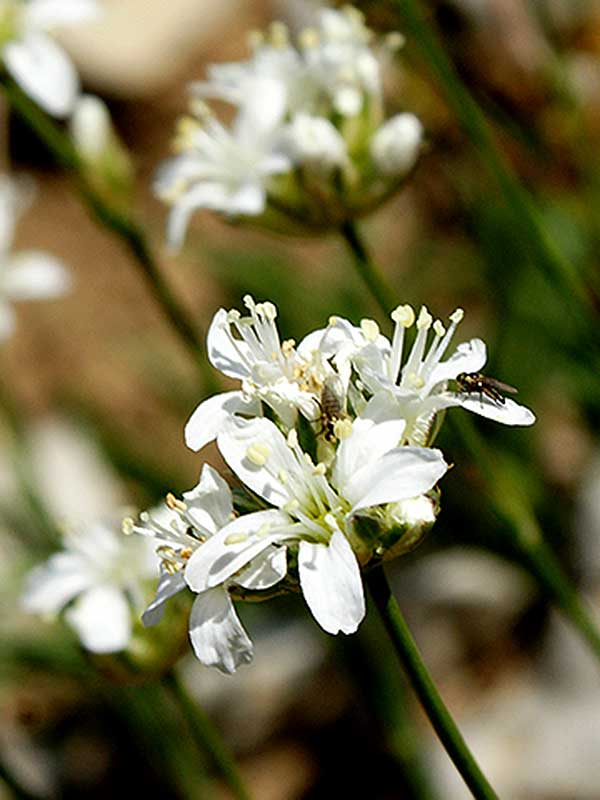Eremogone capillaris / fescue sandwort
- five petals, white, in clusters of ca. 3 flowers per stalk
- prominent stamens with large anthers
- grass-like (fescue-like) opposite leaves
- in clumps or mats, in rock cracks and rocky meadows
- alpine and subalpine
Also known as: mountain sandwort, slender mountain sandwort, beautiful sandwort, thread-leaved sandwort
Synonym: Arenaria capillaris
See also: Eremogone congesta / sandwort; Eremogene kingii / King’s sandwort
Fescue sandwort is a perennial herb growing from a branched caudex. It forms clumps or loose mats, in rocky areas, alpine meadows and some forest habitats. The photos in the gallery here were taken on the Tin Cup Trail in early August.
The vegetative plant is characterized by stems that are erect and simple, and thin, thread-like, opposite, flexible leaves. The leaves are soft to the touch. Sort of like a grass. Perhaps fescue.
The fescue sandwort inflorescence has only a few flowers, spread out a bit at the ends of their stems. The stems are only 2-6 inches tall with only 2 or 3 pairs of leaves. They tend to be glandular-hairy.
The individual flower stalks have only a few, small flowers, on pedicels less than ¾ inches long. The individual flowers are only ½ inch across. Each has 5 white petals that are longer than the purple-tinted sepals, and 10 stamens. Like the stems, and like a lot of other species in this family, the sepals are glandular.
Frankly, none of this description seems to me like it would positively identify anything. It wouldn’t even really tell you that the plant was in the caryophyllaceae. It won’t necessarily tell you that you aren’t looking at one of the other sandwort species on the site. There is a reason for this.
Arenaria/Eremogone is considered one of the most difficult genera to parse out in western North America, partly for the vast and confusing array of morphological types… even within a single population. Because of that, it might have been more reasonable to simply consider the three species on this site by genus alone, but what fun would that be. For the moment, therefore, I am identifying these photos as E. capillaris var americana. This more “definitive” name reflects the fact that otherwise, the species is limited to very northern Canada and Alaska (as well as Eurasia).
The confusion over positive identification is not just limited to the likes of us. In 1969, M. F. Baad, an actual botanist, reported populations from Idaho and neighboring states that he considered to be intermediate between var. americana and Eremogone kingii var. glabrescens, or between var. americana and E. congesta var. prolifera.
One more confusion – despite the fact that the official name of this genus is Eremogone, it must be a recent change. If you google it, you will find almost nothing. Instead, you’ll have to look for Arenaria capillaris.
Regardless, it is a sandwort, and pretty. So enjoy whatever you decide to call it.
| Color | |
|---|---|
| Family | |
| Blossom size | |
| Inflorescence size | |
| Inflorescence type | |
| When? | |
| Where? |


